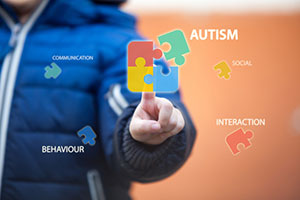
Does my child have autism?
If you’re asking this question, chances are you already have some serious concerns… and that alone is enough to make most parents feel scared, bewildered, and alone.
But the fact is, many parents find themselves looking for signs of a possible problem and asking this question simply out of an abundance of caution. That’s just good parenting and it’s only natural with the amount of attention autism spectrum disorder (ASD) has received in recent years.
The good news is, most of the time concerned parents discover that everything is absolutely fine. Noticing a single red flag or even identifying a combination of concerns often amounts to nothing more than a child’s individuality expressing itself as some slight variation in normal developmental progress.
And on the other side of the coin, even if there is reason to believe your child may legitimately be exhibiting early signs and of autism and does indeed fall somewhere on the spectrum, the news is still good: You are not alone… Your child will go to school just like the other kids and learn in a regular classroom… You will get the help you need and your insurance will cover most of the expense… Breathe – everything is going to be all right.
Before you start arriving at any conclusions at all, it’s important that you’re very clear about one thing: You may be able to identify some traits that indicate the possibility of autism, but only a medical professional is in a position to say for sure.
The autism spectrum varies widely, but according to Washington Autism Alliance and Advocacy, about 46% of individuals on the spectrum have normal or even above average intelligence, while 25% show more obvious signs like being completely nonverbal or having very limited language proficiency at the stage you would expect the child to begin experimenting with verbal communication.
Early signs of autism usually present themselves when children are between one and three years old, though in plenty of cases it isn’t identified and diagnosed until much later. Mild autism may only present itself once the child is in school and starts showing some signs of difficulty with social interactions or if learning disabilities are identified.
The milder the case of autism, the more difficult it may be to identify, with behavioral specialists often relying on the ADOS test, a systematic and standardized method of identifying kids that may fall somewhere on the spectrum. However, even children on the high functioning end of the spectrum can benefit greatly from early intervention behavior therapy.
Though it may be harder to identify ASD before the child reaches school age, there are a variety of autism symptoms in children you can lookout for.
According to the National Autism Association, signs of autism in children typically present themselves through any combination of four deviations from the norm:
- Difficulty with social interactions
- Cognitive impairment
- Difficulty with communication
- Repetitive behaviors
A Basic Primer On the Early Signs and Symptoms of Autism in Children
What Age Does Autism Usually Show Up?
This neurological disorder usually presents itself when children are between one and three years old, though in plenty of cases it isn’t identified and diagnosed until much later.
Most parents find out about their child’s disorder in a similar fashion. However, it can be difficult for many new parents to spot signs of autism in young children because those symptoms can vary considerably and even overlap with other disorders, or even with unusual behaviors that are nonetheless found in neurotypical children.
Signs of autism in children all find root in one of three different categories:
- Communication
- Social skills
- Behavioral patterns
Even as infants, children learn to make eye contact with their parents, smile when they are being smiled at, and point or wave at things they find interesting, such as an animal at the zoo or a favorite toy.
Children on the autism spectrum have a harder time recognizing emotion in facial expressions and may show little to no emotion themselves.
Difficulty with social skills are very often the first early childhood signs of autism. Social skills don’t come natural to those with ASD, and some early signs of autism show up during periods when children would ordinarily develop these skills, usually before age two.
No single early sign of autism necessarily means that a child has ASD. However, a combination of these at least means that it is time to get a professional opinion.
At What Age is Autism Diagnosed?
The observant parent may begin to see some indications of ASD as early as infancy and some stronger clues at around 18 months old. But according to the CDC, age 2 is about the time an experienced ABA, psychologist or other behavior specialist would be in a position to make a reliable diagnosis.
The CDC has even developed a program for parents who find themselves asking, “what are the early signs of autism?” The Learn the Signs: Act Early program offers free resources to help parents identify ASD and make decisions early about treatment options. These kinds of at-home screening measures can lead to a proper diagnosis and early interventions that could do wonders for a child’s social and behavioral development.
Communication Difficulties Can Be One of the Early Signs of Autism
Because all children develop at different rates, communication-related symptoms can be some of the hardest for parents to spot. A general delay in the development of speech and language skills can simply be put down to normal variation. But other communication problems are easier to spot:
- Consistently flat or musical voice.
- Consistent repetition of certain words of phrases.
- Problems with pronoun use (referring to themselves as “you”).
- Unable to pick up common gestures.
Signs of autism in children who are a bit older can include the inability to carry on a conversational thread and being unable to recognize jokes or sarcasm.
Here are 7 tips for communicating with children with ASD.
Social Difficulties Show Up as One of the Signs of Autism in Young Children
Social skills are difficult for ASD patients to develop and some early signs of autism show up during periods when children would ordinarily develop these skills, usually before the age of two. Some social response indicators that present as autism symptoms in children include:
- Not responding to their name
- No interest in interaction with people; a preference for being alone
- Very averse to physical contact and may even experience extreme discomfort
- Inability to react to the emotional displays of others; when someone is hurt or scared, they will not recognize it
Certain Unusual Behavioral Patterns Can Be Strong Signs of Autism in Children
For many parents, it is the behavioral aspects of the disorder that first make it clear there is something very unusual about their child. These patterns can emerge long before communication and social skills normally develop and will tend to strike even new parents as odd. These things might include:
- Inability to make eye contact
- Repetitive behaviors like waving arms, jumping, or rocking in place
- Fixations on certain objects or activities
- Rejection of any activities outside a set routine
- Sensitivity to light, touch, and sound
- Hyperaggression
- Extremely short attention span
A 5-Point Checklist to Use When Looking for Early Signs of Autism in Children
Now that you have a pretty good understanding of what to look for, you can take some easy steps toward identifying possible early signs of autism in your child. You know your child better than anyone, which means you know their baseline behaviors and responses to different stimuli in different situations. This puts you in a unique position to make a good basic assessment.
Of course, you’re not going to be able to make an official diagnosis yourself, only an experienced professional can do that. But by identifying the possibility that your child may be exhibiting some early signs of autism, you’ll be able to make an informed decision about next steps in diagnosis, and possibly treatment.
Use this convenient five-point checklist to identify the early signs of autism in your child:
1. Autism Symptoms in Children Can Include Being Easily Startled by Sounds or Agitated by Background Noise
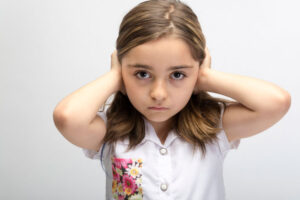 Although all children may exhibit adverse reactions to loud sounds, children with ASD have a particularly strong aversion to loud noises that may cause them to react by grimacing or wincing, rather than showing surprise or a normal wide-eyed curiosity.
Although all children may exhibit adverse reactions to loud sounds, children with ASD have a particularly strong aversion to loud noises that may cause them to react by grimacing or wincing, rather than showing surprise or a normal wide-eyed curiosity.
It may be symptomatic of autism if you see your child convey their strongest emotions in the form of an adverse reaction to the music or TV being turned up too loud… or if adults in the room are having a loud and animated conversation… or if other children are playing nearby are making loud sounds… or even when you run the vacuum cleaner.
This is something worth paying close attention to.
Because children with autism process the world around them differently, they may have trouble filtering out “irrelevant” sounds coming from the microwave or washing machine; sounds that would disappear as white noise in the background for neorotypical children.
These reactions may result in fits, crying, anger, or even physically aggressive behavior—the reaction differs based on the child and the severity of their sensitivity to noise.
2. Failure to Recognize Facial Expressions and Not Making Eye Contact Can Be Early Signs of Autism
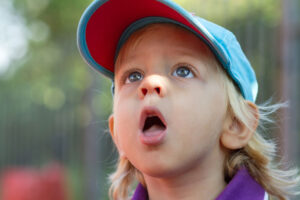 From an early age, children learn to make eye contact with their parents, smile when they are being smiled at, and point or wave at things they find interesting, such as an animal at the zoo or a favorite toy.
From an early age, children learn to make eye contact with their parents, smile when they are being smiled at, and point or wave at things they find interesting, such as an animal at the zoo or a favorite toy.
Children on the autism spectrum have a harder time recognizing emotion in facial expressions and may show little to no emotion themselves. When something startling occurs (like if something falls off the counter and makes a loud noise, for example), it’s actually normal for a child to look to their parent and in seconds process their facial expression to identify what emotion is being conveyed. This is done as a way to verify if they too need to be concerned with what just happened. With an autistic child, however, there is often no reaction at all, which for a parent, can be very puzzling and concerning.
Older children with ASD (from the ages of three to five) will often look at the ground or let their eyes wander when an adult is speaking to them; making eye contact is often a key struggle for children with ASD.
Because children on the spectrum have trouble reading facial expressions, they may fail to react – or even react inappropriately – when a parent or sibling is expressing joy, anger, or sorrow.
3. Speech and Language Difficulties May Present as Early Signs of Autism
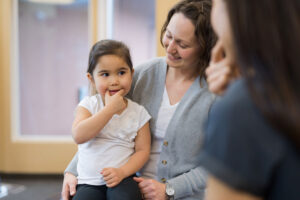 Children with ASD may have a hard time speaking and communicating at the expected level for their age.
Children with ASD may have a hard time speaking and communicating at the expected level for their age.
Even during infancy, you might notice that your child does not babble or coo in response when you talk and attempt to interact. By their first birthday, most toddlers can speak a word or two, but autism symptoms in children often include delayed speech.
Sometimes, children with ASD babble and coo in the first few months of life, and then cease to “communicate” altogether. In these cases, all forms of verbal communication and normal language development and experimentation with speech abruptly stop. This can be disconcerting for parents and is often a sign of autism in young children and an indicator that it’s time to investigate further by seeking professional help.
Even in cases where autistic children do speak and demonstrate pretty typical signs of normal language development, they often repeat unrelated words and phrases over and over and, in essence, speaking without really communicating or conveying a feeling, thought or desire.
Early intervention is key to helping autistic children learn to communicate, whether it is through spoken language, or in more extreme cases, through sign language or even an alternative augmentative communication device.
4. A Lack of Interest in Interacting with the World Is One of the Primary Signs of Autism in Children
 For the neurotypical child, the world is full of bizarre and wonderful things that they have never seen or encountered before; things that naturally pique their curiosity and draw them in. The normal response to a new experience or discovery is typically wide-eyed wonderment, dismay, amusement and inquisitiveness.
For the neurotypical child, the world is full of bizarre and wonderful things that they have never seen or encountered before; things that naturally pique their curiosity and draw them in. The normal response to a new experience or discovery is typically wide-eyed wonderment, dismay, amusement and inquisitiveness.
Children with ASD respond to the world very differently. You might notice that your child doesn’t really respond with eye contact or normal outward signs of curiosity when you try to get their attention. Perhaps they don’t even turn their head in your direction when you say their name. They might not point at objects, show a normal level of curiosity, or attempt to engage you by showing you their toys and drawings in an effort to share their interests and elicit a positive response.
A lack of responsiveness to stimuli and a lack of interest in trying to seek parental attention is a pretty common sign that a child may fall somewhere on the spectrum.
Children typically learn through imitation. Even at an early age, the neurotypical child will begin copying adult behaviors—you might catch them pretending to cook, holding an object up to their ear as if they are talking on the phone, or pretending to feed and care for a doll.
On the other hand, children on the spectrum often don’t attempt to play games or occupy themselves in a way that involves pretending or imitating these kinds of behaviors, and often have minimal interest in interacting with or seeking the attention of adults in their life.
Children with ASD may also show little interest in the other children, whether siblings, other kids at the playground or classmates in their preschool. Even at a very early age, typically developing children are often very curious and reactive when they encounter other children, especially for the first time. Even if your child hides behind your legs or otherwise demonstrates some shyness or trepidation, the fact that other kids their age are eliciting a response of some kind would indicate normal development.
However, because the autistic child struggles to detect another child’s emotions and interpret facial expressions, the social world can be overwhelming and their response is often to simply shut down and avoid interacting and showing interest altogether.
Children on the spectrum may also have adverse reactions to normal physical contact, such as a hug, holding hands, or being picked up off the floor and held.
5. Overreaction Or No Reaction to Sensory Stimuli May Be One of the Early Signs of Autism
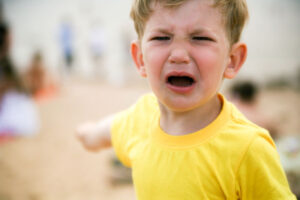 Many autistic individuals have trouble processing sensory information and can become easily overwhelmed, even on an outing to a restaurant or grocery store. Sights, sounds and movements, even tastes and smells, can all be overwhelming to the autistic child, especially in combination with one another.
Many autistic individuals have trouble processing sensory information and can become easily overwhelmed, even on an outing to a restaurant or grocery store. Sights, sounds and movements, even tastes and smells, can all be overwhelming to the autistic child, especially in combination with one another.
This may present itself as one of two extremes: you may notice either an observable overreaction or an under-reaction to stimuli.
In the case of an overreaction, an autistic child may flinch away from touch, even something as gentle and unthreatening as a pat on the head or a touch on the arm. Others may throw a fit when getting dressed because the tactile sensation of the clothing creates a feeling of anxiety.
Some children with hypersensitivity to noise and other stimuli may react in the opposite way—they may show no response at all to sounds and visual stimuli, even things that would usually startle or surprise a child. This might strike you as so unusual that it causes you to wonder if your child is having difficulty hearing. An autistic child may also have no reaction to sensory stimuli that would ordinarily be fun, curious and exiting, something that can be just as disconcerting for a concerned parent.
Even a strong negative reaction to something new and overwhelming is somewhat normal, but no reaction at all can be cause for concern since it is one of the tell-tale signs of autism in young children. If you’re at the circus for the first time and a clown doesn’t cause your child to react normally by either laughing or freaking out a little, it may indicate that further evaluation is needed.
ABA therapy can do wonders for sensory processing disorders, which are often a part of ASD, but also may affect neurotypical children.
Interpreting your child’s responses and reactions often requires a little parental intuition since there is no absolute baseline for normal. But if some of these ASD markers seemed too familiar to ignore, it’s a good idea to see your family doctor for a diagnosis to settle your concerns, or to begin the process of getting your child the therapy they need.






